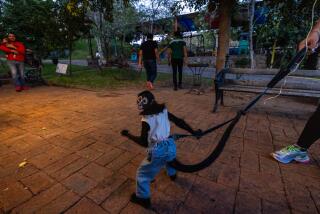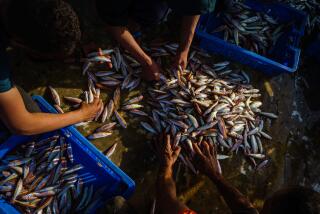Environment : The Skin Trade : * Endangered reptiles are getting some unlikely allies in Latin America: hunters and farmers. It’s all part of an effort to tame illegal commerce in hides.
- Share via
SANTA MARTA, Colombia — Should rare reptiles be protected--or skinned?
Apparently both, according to scores of environmentalists, scientists, game managers and hide traders. The seemingly contradictory goals were advanced by these experts earlier this month at a conference here.
They argue that the best way to preserve members of the crocodile family and other threatened wildlife in Latin America is by encouraging regulated trade in their hides and other byproducts. They hope that legal trade will blossom and crowd out the huge illegal market--and provide a way to educate hunters about conservation and replenish wildlife stocks.
The buzz phrase is “sustainable use,” a concept opposed by some environmentalists. This describes management programs such as ranching, in which ranchers are allowed to take a certain number of eggs each year from the wild to hatch and raise in captivity for sale; farming, in which the species is bred from adults on farms; and fixing quotas for hunting, called “wild harvesting.”
Creating a legal market gives regulated hunters, breeders and ranchers an economic incentive to crack down on poachers--their competitors. And government-regulated breeders are required to return part of their breeding stock to the wild each year.
The experts say sustainable-use programs like those under way in Colombia, Venezuela and other countries are especially important for the caiman ( Caiman crocodilius ) and other crocodilians condemned as man-eaters by rural people in Latin America and around the world.
As Exhibit A, a grisly photo of a child’s body being pulled out of a crocodile’s stomach was displayed at the conference.
“You couldn’t design a better animal to prove our point,” said John Hutton, a Zimbabwe-based wildlife consultant and vice chairman for Africa of the crocodile specialist group meeting in Santa Marta. “Native people are not going to protect these animals without an economic incentive.”
The specialist group is part of the World Conservation Union, the globe’s largest environmental group, which receives governmental and private funding.
The “skin-trade” issue threatens to divide an important March meeting of the Convention on International Trade in Endangered Species (CITES) in Kyoto, Japan. Latin American caiman traders are likely to find themselves in the center of the controversy pitting those who want to extend sustainable use to other species against those who don’t.
Latin America has an enormous stake in the controversy. About two-thirds of the worldwide trade in crocodile-family skins--alligators, crocodiles and caimans--is illegal, and Latin America accounts for more than 90% of that trade. It also is the major player in legal trade.
“The caiman trade in Latin America is an example of just how necessary sustainable use is and how well it can work,” said Harry Messel, the crocodile group’s chairman.
Messel led about 150 crocodile specialists from 20 countries to the group’s Latin American regional meeting in Santa Marta as a show of support for Colombia, which has finally moved to legalize and control its caiman trade after years of ineffectually trying to ban it.
In just two years, an explosion of caiman breeding farms in Colombia has drastically increased the country’s legal exports of skins and reduced its black market. In 1987, when the program began under the direction of environmental authorities, there were seven breeding farms in Colombia. Today there are 84.
Legal hide exports have risen from under 6,000 in 1989 to more than 113,000 this year, allowing Colombia to surpass Venezuela as Latin America’s leader in foreign sales.
The picture was much different in the 1950s, when hunters began stalking caimans after other species of larger crocodilians with better hides were pushed to the verge of extinction. Trade bans passed by Latin American countries in the early 1970s were intended to avoid a similar fate for the caiman, but a huge black market in hides nevertheless arose in countries including Colombia, Brazil and Venezuela.
According to one conservative estimate, 11,649,000 caiman hides were exported from Colombia alone between 1951 and 1980.
“We simply lost control of this natural resource by pushing the caiman trade underground,” concedes Jose Vicente Rodriguez, the wildlife director of Colombia’s National Institute of Renewable Natural Resources and Environment.
Finally, in the mid-1980s, Colombia joined Venezuela and other Latin American nations in opting for controlled trade in caimans under the guidelines of the CITES treaty, signed by 112 countries including the United States and Western European nations. CITES lists the caiman as an Appendix 2 species, one whose hide can be restrictively traded. Trade is prohibited in products of animals listed as Appendix 1, including 12 crocodile species.
Still, some environmentalists continue to be wary of such programs. They say the black market in caiman skins has not been reduced fast enough by the legal trade. In the early 1980s, poaching provided 80% to 90% of the total skin trade. It still accounts for 60% to 70% today, according to the World Wildlife Fund. Caiman skins, almost all of them from Central and South America, account for 1.25 million of the 1.5 million hides sold annually worldwide.
Jeff Canin, the trade expert for Greenpeace, said in a telephone interview from London that although the environmental organization is willing to tolerate trade in some species, the tests for inclusion in such programs must be stringent.
“Many of these so-called sustainable use programs look good on paper, but they are really not sustainable at all,” he said. “Once you put these programs into effect, you run up against greed and the need to expand business, and that is never good for the species.”
Indeed, some caiman traders, smarting from price drops caused by the world recession, are demanding even higher quotas, hoping that higher volume will compensate for low prices.
Countries that tan and refine reptile skin products also must help limit the illegal trade, specialists at the Santa Marta meeting said. They passed a resolution threatening to cut off all skin trade with Italy and Singapore, two major refining countries that continue to buy illegal skins. During the conference, Italy approved a law creating criminal penalties for people who buy and sell illegal skins--a step toward enforcing CITES.
Despite the obstacles, Messel, the crocodile group’s chairman, is optimistic about getting a handle on the skin trade.
“In a few years, the legal trade will smother the illegal trade,” he predicts. “With Colombia’s program, we’ve reached a turning point in finally beating the Latin American black market. We will finally be able to control trade to the benefit of the species.”
A Look at Crocodilians
Crocodiles, alligators, caimans and gavials are crocodilians, rare survivors of an ancient order of amphibious reptiles. Crocodilians flourished with dinosaurs about 250 million years ago. The largest, about 50 feet long, lived in the Rio Grande Valley and probably fed on dinosaurs. Today’s crocodilians are smaller and confined mostly to the world’s tropical regions. They are hunted for their hides, used in shoes and handbags; many species are in danger of extinction. Most of the skin trade is in the black market, frustrating efforts to protect endangered species.
The Common Caiman: Easily mistaken for a crocodile, the Common Caiman is extremely adaptable to different habitats and is the most widespread. An adult may reach up to 10 feet in length.
The Crocodile: The crocodile’s head tapers to a point and its teeth are pretty well lined up. The enlarged teeth on the lower jaw can be seen from the side, even with a closed mouth.
The Alligator: It has a broader, more rounded snout than the crocodile, and its upper teeth are placed outside the line of teeth in its lower jaw. Teeth are hidden when its jaw is shut.
The Gharial (Gavial Group): The snout is slender with a distinctive knob on the tip. The jaws contain more than 100 teeth. A large animal, it can grow to 21 feet in length but has relatively weak legs. The only remaning species is in Asia.
Crocodylidae Family
Crocodile Subfamily True and Dwarf Crocodiles False Gharial
Gavial Subfamily Gharial
Alligator Subfamily True Alligator Camans, Dwarf and Black
Legal Skin Exports Latin America: 200,000 United States: 150,000 (may be as high as 200,000 ; all American Alligators Asia: 50,000 Africa: 40,000
Colombian Exports
Number of caiman skins authorized for export: 1989: 5,990 1990: 55,852 1991: 113,860
The Consumers
Estimated retail sales of crocodilian skins, all types: Japan: 30% United States: 25% Italy: 20% France: 20% Other: 5% (Divided among other European countries, Korea, and Taiwan)
More to Read
Sign up for Essential California
The most important California stories and recommendations in your inbox every morning.
You may occasionally receive promotional content from the Los Angeles Times.










